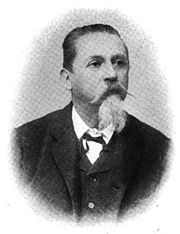
Pietro Tacchini
Encyclopedia

Italy
Italy , officially the Italian Republic languages]] under the European Charter for Regional or Minority Languages. In each of these, Italy's official name is as follows:;;;;;;;;), is a unitary parliamentary republic in South-Central Europe. To the north it borders France, Switzerland, Austria and...
astronomer
Astronomer
An astronomer is a scientist who studies celestial bodies such as planets, stars and galaxies.Historically, astronomy was more concerned with the classification and description of phenomena in the sky, while astrophysics attempted to explain these phenomena and the differences between them using...
.
He was born and raised in Modena, Italy. He studied engineering at the University of Padova. At the age of 21, he was appointed the director of a small observatory in Modena. By 1863 he became the Primo Astronomo Aggiunto, or director of the observatory, at Palermo, Italy. He remained there until 1879, and focused most of his attention on observations of the Sun.
In 1865 he founded the specialist physical astronomy journal, Memorie della Società degli Spettroscopisti, and remained the editor until 1905. (This publication later became the Memorie della Società Astronomica Italiana in 1920.)
Tacchini established an observation network with other Italian astronomers to spectroscopically examine the sun at about the same time daily. He likewise organized an observatory in Calcutta to watch the sun when conditions were unfavorable in Italy
Italy
Italy , officially the Italian Republic languages]] under the European Charter for Regional or Minority Languages. In each of these, Italy's official name is as follows:;;;;;;;;), is a unitary parliamentary republic in South-Central Europe. To the north it borders France, Switzerland, Austria and...
. In 1874 he led an expedition to Muddapur, India
India
India , officially the Republic of India , is a country in South Asia. It is the seventh-largest country by geographical area, the second-most populous country with over 1.2 billion people, and the most populous democracy in the world...
to observe the transit of Venus
Transit of Venus
A transit of Venus across the Sun takes place when the planet Venus passes directly between the Sun and Earth, becoming visible against the solar disk. During a transit, Venus can be seen from Earth as a small black disk moving across the face of the Sun...
across the sun.
In 1879 he was summoned to Rome
Rome
Rome is the capital of Italy and the country's largest and most populated city and comune, with over 2.7 million residents in . The city is located in the central-western portion of the Italian Peninsula, on the Tiber River within the Lazio region of Italy.Rome's history spans two and a half...
where he succeeded Angelo Secchi
Angelo Secchi
-External links:...
at the Osservatorio del Collegio Romano. In 1881 he became head of the Ufficio Centrale di Meteorologia.
Due to his influence, the Bellini Observatory was completed on Mount Etna
Mount Etna
Mount Etna is an active stratovolcano on the east coast of Sicily, close to Messina and Catania. It is the tallest active volcano in Europe, currently standing high, though this varies with summit eruptions; the mountain is 21 m higher than it was in 1981.. It is the highest mountain in...
where Pietro believed that the high altitude would improve the spectroscopic observations of the sun, and potentially allow direct observations of the solar corona
Corona
A corona is a type of plasma "atmosphere" of the Sun or other celestial body, extending millions of kilometers into space, most easily seen during a total solar eclipse, but also observable in a coronagraph...
without an eclipse. He also recommended the construction of the Catania Observatory in 1885.
The crater Tacchini
Tacchini (crater)
Tacchini is a lunar crater on the northwestern edge of the Mare Smythii, near the eastern limb of the Moon. It lies just to the south of the prominent crater Neper, and was designated Neper K before being given its current name by the IAU...
on the Moon
Moon
The Moon is Earth's only known natural satellite,There are a number of near-Earth asteroids including 3753 Cruithne that are co-orbital with Earth: their orbits bring them close to Earth for periods of time but then alter in the long term . These are quasi-satellites and not true moons. For more...
is named after him.

